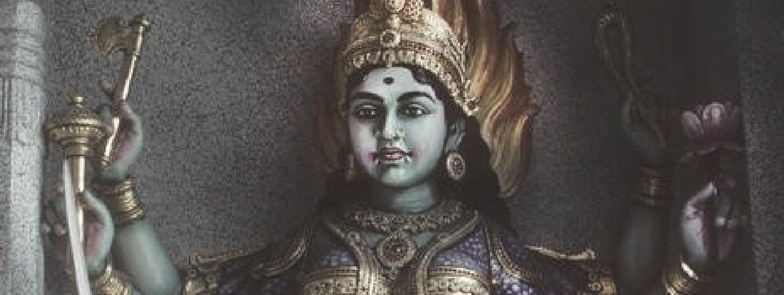Bhairavi: The Warrior Goddess
30 Mar 2020 12:15:20

By Rajendra Diwe :
Maa Bhairavi is the fifth among Dasha Mahavidyas. As the name indicates, Bhairavi means frightful, terrible, horrible or formidable. According to Swami Vivekananda, “Bhairavi provokes different fears. For, she is said to shine with the effulgence of 10,000 rising suns. She has many names including Tripura Bhairavi, Sampath Praja Bhairavi, Kaulesh Bhairavi, Siddhida Bhairavi, Bhay Vidwamsi Bhairavi, Chaitanya Bhairavi, Kameshwari Bhairavi, Nitya Bhairavi, and Rudra Bhairavi. Her body is the color of the rising sun.” Swami Ishanananda, a disciple of Sarada Devi, has written a remarkable story in his book ‘My Blessed Days With Holy Mother: Reminiscences of Holy Mother Sri Sarada Devi’.
He described Bhairavi as ‘Terror’ or ‘awe-inspiring’. So, the one who has achieved the state of Bhairavi, is beyond the fear of death, which, in Vedanta, one calls the state of Brahman, he added. Goddess Bhairavi is also called ‘Tripurabhairavi’, meaning the goddess of three ‘Puras’ fortress/castle, city, and town. ‘Tripura’ convey three different stages of consciousness -- awakening, dream, and deep sleep. Iconography shows the goddess as holding book, rosary, and making fear-dispelling and boon-conferring gestures. Devadatta Kali alias David Nelson, a close associate of Vedanta Society, offers another take on it. “Bhairavi is seen mainly as the Chandi in the Durga Saptashati, who slays Chanda and Munda. Sometimes, she is in the cremation ground, seated on a headless corpse.
Like Kali, she has four arms,” he stated. In two hands, she holds sword of knowledge and demon’s head representing destruction of ego. Her other two hands display ‘Abhayamudra’ urging devotees not to have fear, and ‘Varadamudra’ that is the gesture of granting boons. More often they hold a ‘mala’ signifying devotion, and a book signifying knowledge. The trident represents pervasively three-fold nature of her manifestation and can be interpreted in a variety of ways. “It is often said that Bhairavi represents divine wrath, but it is only an impulse of her fierce, maternal protectiveness aimed at destruction of ignorance and everything negative that keeps us in bondage. In that aspect, she is called Sakalasiddhibhairavi, the granter of perfection,” he states.
“Bhairavi represents the supreme power of speech, which has the nature of fire (Tejas). She is the Word in its unarticulated and primal form as raw energy, the flaming word which appears like a pillar or a sword to remove all opposition. She is the supreme light and heat power, the flame of consciousness itself (Chidagni) which is the ultimate knowledge of truth. Bhairavi as Tejas radiance rules over the Tanmatras, the subtle sensory potentials behind the five elements and five sense organs which allow for their inter-connection. Through the Tanmatras Bhairavi gives power over the senses and the elements. She is the basic will power of life, mastering which we come to control all of its manifestations,” David Nelson elaborates. Swami Ishanananda describes Bhairavi as having three eyes and wearing a jeweled crown with the crest of the moon. “Her lotus face is happy and smiling.
She wears a red garment (generally made of silk), her breasts are smeared with blood, and she is adorned with a garland of severed human heads. She has four hands and carries a rosary and a book. She makes the gestures of knowledge and that for giving boons with the other two hands. We can think of Bhairavi in cosmic terms or in an individualistic sense.
As a cosmic goddess Bhairavi is closely identified with Durga in her fierce form, known as Chandika. Because Durga presides over the birth, sustenance, and death of the universe, she projects three primary facets, called Mahakali, Mahalakshmi, and Mahasarasvati. These extremely subtle and immeasurably powerful aspects of consciousness manifest on the material level as the three gunas, the basic building blocks and driving energies of the universe.” In her individualised aspect, Bhairavi is the power of consciousness dwelling in every human being. She is known as Kundalini. Basic to both the cosmic and individual aspects is identification of Bhairavi with tremendous power.
In either aspect, she can appear as overwhelming. The innate capacity to know, to experience, the Divine lies latent within every human being, and spiritual life unfolds through various stages of discovery. When one sets out on spiritual path, one starts seeking by making a conscious effort of some sort, but then what one finds isn’t necessarily what one expected. If one has not sufficiently prepared to receive it, the light of spiritual knowledge may blaze so strongly that one may have all of familiar and comfortable assumptions about the world and self suddenly shattered. One may lose one’s bearings for a while, but the extraordinary nature of spiritual discovery causes one to see the world in a new light and have a different relationship with it.
